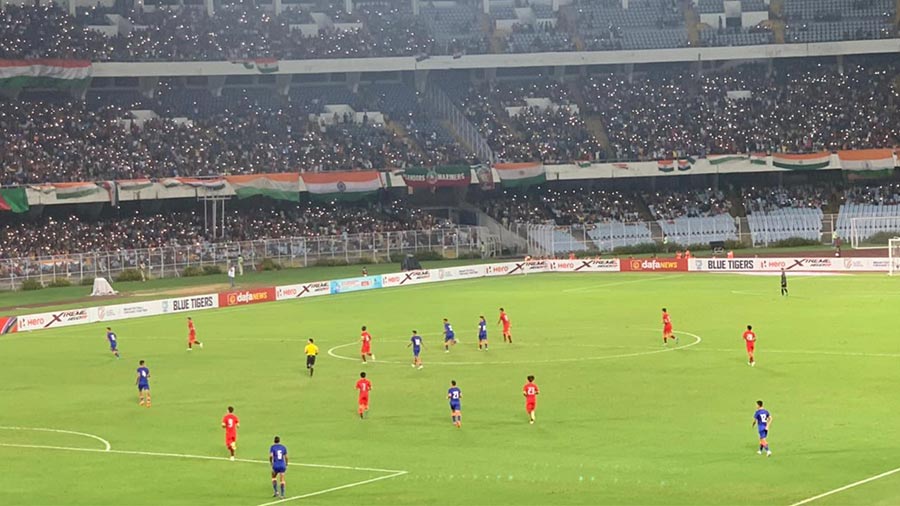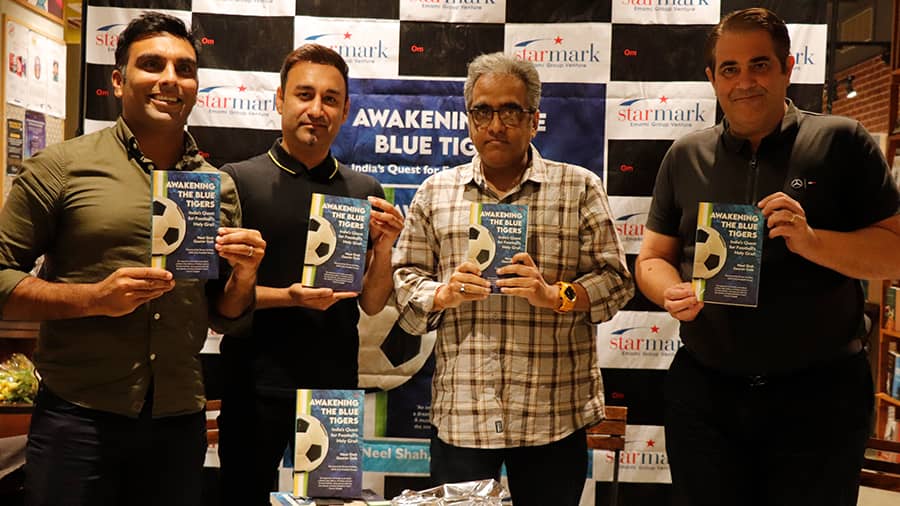In Awakening the Blue Tigers, published recently by Om Books International, Neel Shah, a sports professional and educator, and Gaurav Gala, a veteran broadcast journalist, take a deep dive into football in India — its aspirations, challenges and stories.
Below is an excerpt from the book that provides a sample of what Shah and Gala’s labour of love has to offer. You can purchase your copy here.
How cricket in India affected football
Much has been written about why a country with over a billion people, comprising 17.7 per cent of the world’s population, that has found a way to achieve global dominance in cricket, cannot field eleven players who can compete at the highest levels in Asia….
The story begins back in 1983 when a team made up of underdogs, led by Kapil Dev, held on to beat the mighty West Indies at the historic Lord’s Cricket Ground in England, thus winning the hearts of an entire nation and earning the respect of other cricket-playing countries. This sparked a cricket revolution in India that channelised most media coverage, corporate spending and government support into furthering a game that put India on the global sports map. While this was great for cricket, it meant that there were limited resources available to develop other sports that could greatly benefit from media, corporate and government support.
Indian football experienced a “golden era” from 1950 to 1964. During this period, the country was ‘invited’ to play in a FIFA World Cup (we did not go), won the Asian Games twice, was placed fourth in the Helsinki Olympics, and finished runners-up in the Asia Cup. However, by 1983, the medals and top international finishes were a distant memory as India’s football ecosystem could not keep pace with the growth that other countries were experiencing.
The cricket mania that followed the historic win at Lord’s made it even more difficult for the country’s football governing body, the All India Football Federation (AIFF), to build the kind of national momentum and support required for India to return to achieving consistent, positive results at the international level. This left the country’s football ecosystem in tatters, full of issues and deficiencies that have taken key stakeholders decades to attempt to address and fix.
The flaws in Indian football’s pyramid

Shah and Gala highlight the biggest structural problems in Indian football TT Archives
It is nearly impossible for footballers to perform at their highest levels if they do not develop basic skills and match awareness during their developmental stages of life. Without quality coaching programs and leagues, most of India’s national team players end up waiting until they can join an academy at the age of 14, before they are in an environment where they get access to quality coaches and regular competitive matches. This is about seven to 10 years after most of their counterparts in countries around the world would be experiencing the same. It is just common sense that one cannot expect Indian footballers to be competitive against the world’s top players if they begin their full-fledged training up to a decade after their competition.
Residential football academies within India struggle to meet the best-practice standards found in academies in Europe, North America, and many countries in Asia. The high expenses associated with establishing, running and growing a world-class residential academy make it challenging for the government, football club owners and private-sector companies to justify this investment. Hence, some of the best academies in India are run by cash-rich corporates such as Tata Steel, Reliance Industries, JSW Group and Vedanta Resources. Again, without the right environment for India’s top footballers to develop, it is difficult to expect them to reach their full potential as athletes and compete with the best in the world.
For the longest time, and even now in many regions across the country, it would be difficult to find a quality grass pitch to play on, what to speak of publicly accessible small or medium stadiums with a decent playing surface. It is not only unsafe for youngsters to play on poor pitches, but it also impacts their ability to develop fundamental football skills. Fortunately, India has experienced a boom in pay-to-rent small-sided turf pitches over the last decade, providing some respite to youth and adults hungry to get some matches in after school or work, or during the weekend.
The majority of the men’s national team currently participates in the domestic professional league, the ISL, which was launched in 2014. The ISL can be credited with several positives, including but not limited to increased investment in Indian football, greater awareness of Indian clubs and footballers, a better quality of packaging and production of the domestic version of the sport and a higher level of foreign representation within Indian football. However, the short format of the league means that Indian national team players do not get as many professional matches as their counterparts playing in leagues across the world. For example, a typical Indian national team player plays an average of 25 to 30 matches in a given year when an average player participating in a European league would play around 50 to 60. The scenario for women is far worse. The numbers just do not lie…
Mock World Cup in Kerala, Messi’s Bengali father and the couple recognised by Pele

Shah and Gala narrate the story of Lionel Messi’s most devoted fan in West Bengal TT Archives
The Indian football picture is not all bleak. Far from it. Despite the challenges experienced by many footballers plying their trade in every stage of the Indian football pyramid, the sport is flourishing in the country. That is the beautiful irony of football’s place in India. Cricket may be a religion in India, but football resides in the hearts of hundreds of millions of Indians across the country. The passion for the beautiful game runs deep, not only in football hotbeds like West Bengal, Kerala, Goa and the Northeast, but also in metros and smaller cities and towns spread across the subcontinent. As stated before, the numbers do not lie. Let’s explore a few important ones:
- Over 350 million people in India annually tune in to watch domestic and international football matches on television or streaming platforms
- Over 300 million Indians annually watch domestic football content via social media platforms
- The FIFA U-17 World Cup 2017 hosted in India created history for being the most attended FIFA U-17 World Cup ever with 13,47,133 fans in attendance — more than the attendance figures of the 2011 ICC Cricket World Cup hosted in India, Sri Lanka and Bangladesh (12,29,826 spectators)
- Domestic matches in West Bengal and Kerala can have attendances of up to 1,00,000 and 80,000, respectively, making these some of the highest-attended football matches in the world
- It is estimated that there are 20 million supporters of Manchester United in India and at least 15 official international club supporter groups active within the country
The real Indian football story runs far deeper than numbers on a page. It is about the communities and personalities that reside in pockets around the country that unabashedly display their love for their favourite countries, clubs and footballers…
Stories like the beautiful people of Pozhiyoor, a sleepy coastal hamlet in the district of Thiruvananthapuram, Kerala. Since 1998, every four years, locals have organised a mock FIFA World Cup where local teams represent some of the countries participating in the global tournament. In addition to the football competition, there are parades, specially themed costumes, and a teak replica of the FIFA World Cup trophy. Celebrations tend to spread into the neighbouring fishing villages as well. The thousands of people connected to the St. Mathews parish love the FIFA World Cup tradition so much that they support the event with whatever resources they can offer.
Stories like the one of Shib Shankar Patra, owner of a tea and snack stall in the Nawabganj township of North 24 Parganas district, West Bengal, and a hardcore fan of the Argentinian national football team. Every four years, he paints his home and stall with the blue and white of the national flag of Argentina and with life-size images of his favourite player, Lionel Messi, whom he considers a son. This display of passion and support for a country 16,500 kilometres away from West Bengal transforms these two structures into a hub for supporters of Argentina or curious onlookers looking to congregate, converse and celebrate the quadrennial event. His love for the Argentinian superstar is so strong that every year during Messi’s birthday he organises a blood-donation drive and, in the past, has ordered a 30 pound cake and distributed 100 Argentina jerseys to youth to celebrate La Pulga’s special day
Stories of the late Pannalal Chatterjee and his wife Chaitali, who had attended every FIFA World Cup since 1982, highlight the lengths die-hard fans go to, to get their fix. The elderly Kolkata-based couple, who had attended 10 consecutive FIFA World Cups in total, serve as an inspiration for football supporters across the country who dream of getting to experience even one FIFA World Cup live in the host country. One of their most special memories was Brazilian legend Pelé recognising them at the airport during the 1994 FIFA World Cup and agreeing to take a picture with the passionate couple…
This book will leave you with an understanding of why people in a perceived ‘cricket country’ care so deeply about teams and players competing in a non-cricket tournament that has no obvious connection to South Asia.


